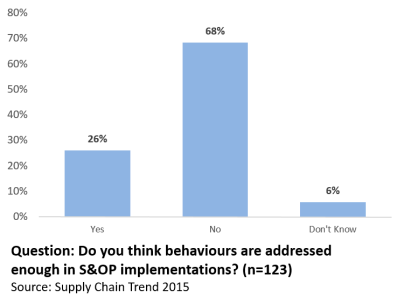It is Saturday morning 8.18 am here in Melbourne and I read that River Logic just put me in their top 10 must read Supply Chain blogs for 2016. Of course I’m very pleased and honoured with this. River Logic correctly calls out that ‘my twist’ is a focus on mindset and behaviours in combination with strategy execution and S&OP.
I also just realized we still got a long way to go in this area.
One of my first blogs, The Behavioural Supply Chain, posted almost exactly 6 years ago, called out the need to address behaviours more seriously in the supply chain. I took that blog serious and in the the last 6 years, I became a behavioural coach and got myself accredited in two psychometric tools. One of them is Life Styles Inventory, the other one Mental Toughness. Both tools measure mindsets and behaviours that a coach can use as a conversation starter to increase effectiveness, but also well-being and performance. I now coach individuals and run team workshops to help people become more effective in their thinking and behaving.
In those last 6 years I also worked with some renowned consultancies on S&OP projects. Some of them call out in every second slide how important behaviours are. I see the same in conferences. Although they call this out as a critical successfactor, they don’t offer any behavioural coaching in their value proposition. Also business leaders talk the behavioural or cultural talk, but don’t walk it! I think indeed behaviours and culture are critical and made a conscious choice not just to pay lipserivce, but to become a behavioural coach and help people and company cultures improve.
In my S&OP pulse check 2015, 68% of practitioners call out that behaviours are not addressed enough in S&OP implementations. Similar to me, they hear the lip service, but see not enough action. When asked what the main cultural change is driven by S&OP, only 26% of participants indicate this is ‘improved constructive behaviours in general’.
A more positive mindset and constructive behaviours are proven to be more effective in S&OP, business and life in general and is better for employee health, well-being en performance. But we still have a long way to go in integrating behaviours properly in S&OP or Supply Chain in general.
It’s 8.40 am now. Time to get my girls to swimming lessons. They’re 5 and 7 and already learned ‘to show grit and not quit’. Commitment and grit are important attributes of Mental Toughness and applicable to almost about everything in life. Not just S&OP or Supply Chain.
Photocredit Crucialskills



Niels, congratulations on making the top 10. On the subject of behavioural change Oliver Wight himself began teaching the need for integration between people (and behaviours), processes and tools 45 years ago. It is still true today. Success in S&OP/IBP is all about people. Organisation leaders have to recognise or they won’t agree to the required investment in behavioural change. Unfortunately we still see examples where millions are spent on tools and systems and next to nothing on people and support for behavioural change with the inevitable result that the new system is under utilised, peoe frustrated and business results unchanged.
Thanks Stuart,
I know Oliver Wight has got behaviours defined as part of the check list. I would love to see you guys take that a step further and not only check if the behaviours are right, but also support the development of those behaviours in a business. As well on individual as on group level.
cheers,
Niels
Hi Niels. Behaviour change is what we focus on through the education and coaching phases of our IBP programs with clients and is at the heart of the Oliver Wight Proven Path for Business Transformation. Unfortunately when you experienced the Oliver Wight approach as a client and we had the pleasure of working with you I believe that your organisation did not fully invest in the coaching support, either financially or in some instances mentally. Unfortunately short term financial imperatives can often derail a change program.
There are many factors involved in behavioural change. Clear leadership is one. Another is the fact that everyone is different and has different triggers. This means that different people take different periods of time to understand, accept and adopt the new way of working (and being). Coaching the process users once an S&OP/ IBP process has been designed and rolled out is an essential element for it to be successful. Reinforcing the positive behaviours and calling out those that don’t support the new way of working is part of the value that external process implementation support can bring and is something that we constantly looking to deliver to our clients.
Stuart,
I think you’re stretching it or we have a very different definition of what coaching is. It is not telling people what to do or how to behave, it is unlocking potential. If behaviour is a potential blocker, it needs to be addressed. You need to spend time to understand people’s personalities and thinking, as self thought drives behaviour. Spending one on one coaching time with a client to get to the bottom of this, I know from experience, is not a great commercial proposition compared to consulting or education.
In almost 4 years working with OW, I received process coaching, not any behavioural coaching, at least not in my definition. Neither formal or informal. Change management at the client you talk about wasn’t easy, but that client invested in the behavioural psychometric tool Life Styles Inventory and that’s where I got my first coaching accreditation.
We might better take this conversation offline. I’m more than happy to have a coffee with you and discuss this further. If behavioural change is at the heart of your proven path, to me it feels like OW has some thinking to do on what ‘coaching’ means.
cheers,
Niels
Niels,
I agree fully with you on how much lip service is given to the behavioral side of things. I regularly get comments from the CEOs we deal with that nobody in the past has ever asked anything of them in S&OP and yet in all the articles you read, every says you must engage the Board. Actually you have to engage each individual member of the Board. That’s different. They all need to understand what behaviors will be required of them.
All our client work is on behaviors even though it is not described as that. The phrases that are used are things like “transformation” and “culture change”, but even when process change is needed, it mostly comes down to behaviors.
Supply Chain Management Review magazine published an article we wrote on just this in January. Maybe you saw it.
Kind regards
Hugh
Thanks Hugh,
I liked the outcome of you survey and the powerful graphs you used. I’ll certainly will have a read of your article as well.
In 2012 I wrote an article in the journal of business forecasting on S&OP, culture and behaviours you might like. You can find it on my blog here: https://supplychaintrend.com/2013/01/16/global-sop-and-leadership/
Cheers,
Niels